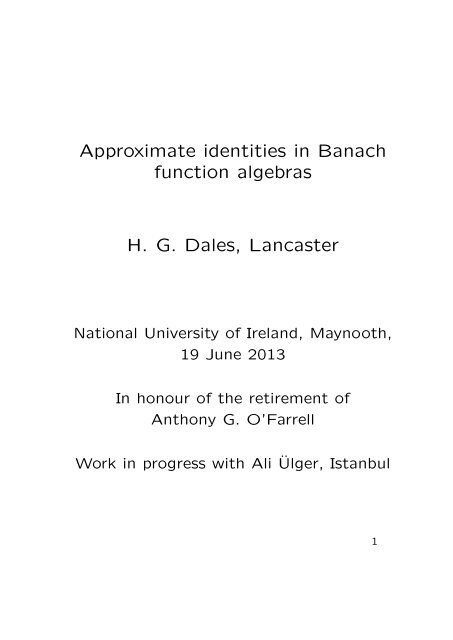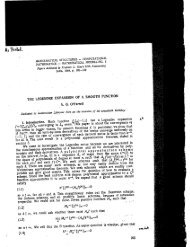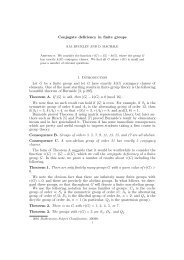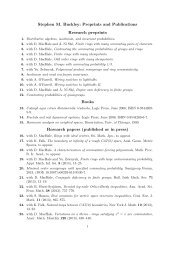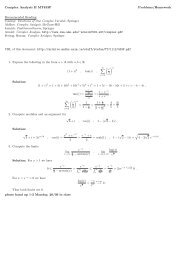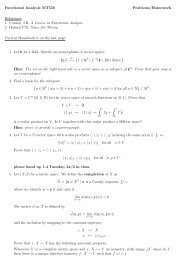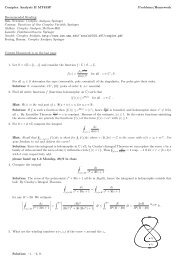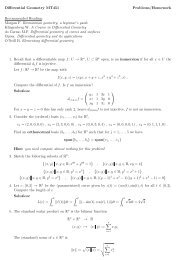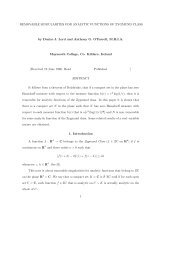Approximate identities in Banach function algebras - National ...
Approximate identities in Banach function algebras - National ...
Approximate identities in Banach function algebras - National ...
Create successful ePaper yourself
Turn your PDF publications into a flip-book with our unique Google optimized e-Paper software.
<strong>Approximate</strong> <strong>identities</strong> <strong>in</strong> <strong>Banach</strong><br />
<strong>function</strong> <strong>algebras</strong><br />
H. G. Dales, Lancaster<br />
<strong>National</strong> University of Ireland, Maynooth,<br />
19 June 2013<br />
In honour of the retirement of<br />
Anthony G. O’Farrell<br />
Work <strong>in</strong> progress with Ali Ülger, Istanbul<br />
1
Def<strong>in</strong>itions<br />
Let K be a locally compact space. Then C 0 (K)<br />
is the space of all complex-valued, cont<strong>in</strong>uous<br />
<strong>function</strong>s on K that vanish at <strong>in</strong>f<strong>in</strong>ity. This is<br />
a commutative <strong>Banach</strong> algebra with respect to<br />
the uniform norm | · | K .<br />
A <strong>function</strong> algebra on K is a subalgebra of<br />
C 0 (K) such that, for x, y ∈ K with x ≠ y, there<br />
is f ∈ A with f(x) ≠ f(y), and, for each x ∈ K,<br />
there is f ∈ A with f(x) ≠ 0.<br />
A <strong>Banach</strong> <strong>function</strong> algebra on K is a <strong>function</strong><br />
algebra A that is a <strong>Banach</strong> algebra for a norm<br />
‖ · ‖, so that ‖fg‖ ≤ ‖f‖ ‖g‖ for f, g ∈ A.<br />
Necessarily, ‖f‖ ≥ |f| K for f ∈ A.<br />
The algebra A is a uniform algebra if it is<br />
closed <strong>in</strong> C 0 (K).<br />
2
Natural <strong>Banach</strong> <strong>function</strong> <strong>algebras</strong><br />
A <strong>Banach</strong> <strong>function</strong> algebra A on K is<br />
natural if every character on A has the form<br />
f ↦→ f(x) = ε x (f) for some x ∈ K. Equivalently,<br />
every maximal modular ideal has the<br />
form<br />
for some x ∈ K.<br />
M x = {f ∈ A : f(x) = 0}<br />
Every commutative, semisimple <strong>Banach</strong><br />
algebra is a <strong>Banach</strong> <strong>function</strong> algebra on its<br />
character space.<br />
3
<strong>Approximate</strong> <strong>identities</strong><br />
Let (A, ‖ · ‖) be a natural <strong>Banach</strong> <strong>function</strong><br />
algebra on K.<br />
An approximate identity is a net (e α ) <strong>in</strong> A<br />
such that ‖fe α − f‖ → 0 for each f ∈ A.<br />
A po<strong>in</strong>twise approximate identity is a net<br />
(e α ) <strong>in</strong> A such that e α → 1 po<strong>in</strong>twise on K.<br />
Clearly, each approximate identity is a po<strong>in</strong>twise<br />
approximate identity.<br />
These approximate <strong>identities</strong> (e α ) are bounded<br />
if sup ‖e α ‖ < ∞ (and the sup is the bound);<br />
they are contractive if the bound is 1. Say<br />
BAI and BPAI, CAI and CPAI.<br />
The algebra A is (po<strong>in</strong>twise) contractive if<br />
every M x has a C(P)AI.<br />
We are <strong>in</strong>terested <strong>in</strong> the best bound of BAIs.<br />
4
Factorization<br />
Let A be an algebra. Then<br />
A [2] = {ab : a, b ∈ A}, A 2 = l<strong>in</strong> A [2] .<br />
Cohen’s factorization theorem Let A be a<br />
commutative <strong>Banach</strong> algebra. Then the follow<strong>in</strong>g<br />
are equivalent:<br />
(a) A has a BAI of bound m;<br />
(b) for each ε > 0, each a ∈ A can be written<br />
as a = bc, where ‖b‖ ≤ m and ‖a − c‖ < ε (and<br />
so A = A [2] , and A factors).<br />
✷<br />
[Much more is true.]<br />
5
Examples<br />
(I) Take K compact and A = C(K).<br />
every M x has a CAI.<br />
Then<br />
Are there any more (po<strong>in</strong>twise) contractive<br />
uniform <strong>algebras</strong><br />
(II) Let G be a LCA group (e.g., G = Z or<br />
G = R), and let A be the group algebra (L 1 (G), ⋆).<br />
The Fourier transform maps L 1 (G) onto the<br />
Fourier algebra A(Γ), where Γ is the dual<br />
group to G.<br />
Now A(Γ) is a natural <strong>Banach</strong> <strong>function</strong> algebra<br />
on Γ. The algebra A(Γ) always has a CAI, and<br />
all the maximal modular ideals M γ have a BAI,<br />
of bound 2 (very standard); further, ‘2’ is the<br />
best bound of a BAI <strong>in</strong> M γ (less well-known;<br />
Derighetti).<br />
6
More examples<br />
Look at natural <strong>Banach</strong> <strong>function</strong> <strong>algebras</strong> on<br />
I = [0, 1].<br />
(III) Take A = Lip α (I), where α > 0, so that<br />
{ }<br />
|f(x) − f(y)|<br />
‖f‖ α = |f| I + sup<br />
|x − y| α<br />
for f ∈ A. If f(0) = 0 and f(1/n) = 1, then<br />
‖f‖ ∼ n α , so there are no BPAI <strong>in</strong> M 0 .<br />
(IV) Look at BV C(I), the algebra of cont<strong>in</strong>uous<br />
<strong>function</strong>s of bounded variation on I. Here<br />
‖f‖ var = |f| I + var(f)<br />
for f ∈ BV C(I).<br />
M 0 of bound 2.<br />
There is an obvious BAI <strong>in</strong><br />
7
The Choquet boundary<br />
Let A be a <strong>Banach</strong> <strong>function</strong> algebra on K.<br />
A closed subset F of K is a peak set if there<br />
exists a <strong>function</strong> f ∈ A with f(x) = 1 (x ∈ F )<br />
and |f(y)| < 1 (y ∈ K \ F ); <strong>in</strong> this case, f<br />
peaks on F ; a po<strong>in</strong>t x ∈ K is a peak po<strong>in</strong>t if<br />
{x} is a peak set, and a p -po<strong>in</strong>t if {x} is an<br />
<strong>in</strong>tersection of peak sets. The set of p -po<strong>in</strong>ts<br />
of A is Γ 0 (A), the Choquet boundary of A.<br />
Its closure is the Šilov boundary.<br />
Theorem Let A be a <strong>Banach</strong> <strong>function</strong> algebra<br />
on K. Then M x has a BAI ⇒ x ∈ Γ 0 (A). ✷<br />
Example Let A be the disc algebra on D. Then<br />
{f ∈ A : f(0) = 0} does not have a BAI. This<br />
is obvious anyway.<br />
✷<br />
8
Uniform <strong>algebras</strong><br />
Theorem Let A be a uniform algebra on compact<br />
K. Then the follow<strong>in</strong>g are equivalent:<br />
(a) x ∈ Γ 0 (A);<br />
(b) M x has a BAI;<br />
(c) ε x is an extreme po<strong>in</strong>t of the state space;<br />
(d) M x has a CAI.<br />
The implication (a) ⇒ (d): Take f that peaks<br />
at x. Then (1 K − f n : n ∈ N) is a BAI of bound<br />
2 for M x . One can modify the <strong>function</strong>s f n <strong>in</strong>to<br />
<strong>function</strong>s g n ∈ A such that (1 K − g n : n ∈ N) is<br />
a CAI for M x .<br />
✷<br />
Def<strong>in</strong>ition A natural uniform algebra on a compact<br />
space K is a Cole algebra if Γ 0 (A) = K.<br />
Important fact There are Cole <strong>algebras</strong> other<br />
than C(K).<br />
9
First question<br />
Question What is the relation between the<br />
existence of a CPAI and a CAI <strong>in</strong> <strong>Banach</strong><br />
<strong>function</strong> <strong>algebras</strong><br />
Remark Suppose that there is a bounded net<br />
(e α ) <strong>in</strong> A such that fe α → f weakly for each<br />
f ∈ A. Then A has a BAI, with the same<br />
bound.<br />
Orig<strong>in</strong>al example – Jones and Lahr, 1977<br />
Let S = (Q +• , +) be the semigroup of strictly<br />
positive rational numbers. The semigroup<br />
algebra A = (l 1 (S), ⋆ ) is a natural <strong>Banach</strong><br />
<strong>function</strong> algebra on Ŝ, the collection of semicharacters<br />
on S. Then there is a sequence (n d )<br />
<strong>in</strong> N such that (δ 1/nd ) is a CPAI for A. However,<br />
A does not have any approximate identity.<br />
This example is not po<strong>in</strong>twise contractive.<br />
10<br />
✷
First question - more examples<br />
Example Let G be a LCA group that is not<br />
compact. Then the m<strong>in</strong>imum bound of a BAI<br />
<strong>in</strong> a maximal ideal of A(Γ) is 2. We can show<br />
that the m<strong>in</strong>imum bound of a BPAI <strong>in</strong> a<br />
maximal ideal is<br />
1<br />
2 (1 + √ 2) > 1 ,<br />
so L 1 (G) is not po<strong>in</strong>twise contractive. We do<br />
not know if this constant is best-possible. ✷<br />
Example Let G be a LCA group that is not<br />
discrete. Let<br />
A = { f ∈ L 1 (G) : ̂f ∈ L 1 (Γ) } ,<br />
∥<br />
with ‖f‖ = max{‖f‖ 1 , ∥ ̂f ∥ }. Then A is a natural<br />
<strong>Banach</strong> <strong>function</strong> algebra on Γ. It has a<br />
1<br />
CPAI, but no BAI.<br />
✷<br />
∥<br />
11
First question - more examples<br />
Example Let B = (L 1 (R), ⋆). Then there is a<br />
s<strong>in</strong>gular measure µ 0 on R such that µ 0 ⋆ µ 0 ∈ B<br />
(Hewitt). Look at A = B ⊕ Cµ 0 as a closed<br />
subalgebra of (M(R), ⋆). Then A has CPAI, but<br />
no approximate identity at all because A 2 =<br />
B, which is not dense <strong>in</strong> A. (Hence CPAI ⇏<br />
factorization.)<br />
✷<br />
Example Let A be a <strong>Banach</strong> <strong>function</strong> algebra<br />
that is reflexive as a <strong>Banach</strong> space. For example,<br />
take the set of sequences α = (α n ) on Z +<br />
such that<br />
⎛<br />
⎞1/2<br />
∞∑<br />
‖α‖ = ⎝ |α n | 2 (1 + n) 2 ⎠ < ∞ ,<br />
n=0<br />
with convolution product, giv<strong>in</strong>g a <strong>Banach</strong> <strong>function</strong><br />
algebra on D.<br />
Suppose that M x has a BPAI. Then A conta<strong>in</strong>s<br />
the characteristic <strong>function</strong> of K \ {x}, and so x<br />
is isolated. Thus maximal ideals of our example<br />
do not have BPAIs.<br />
✷<br />
12
Uniform <strong>algebras</strong><br />
So far we have not given a po<strong>in</strong>twise contractive<br />
<strong>Banach</strong> <strong>function</strong> algebra that is not contractive.<br />
Fact Let A be a natural uniform algebra on<br />
K. Suppose that A has a BPAI (respectively,<br />
CPAI) that is a sequence. Then A has a BAI<br />
(respectively, CAI).<br />
Proof Suppose that (f n ) is bounded and f n → 1<br />
po<strong>in</strong>twise on K. Then f n → 1 weakly by the<br />
dom<strong>in</strong>ated convergence theorem. An earlier<br />
remark now shows that A has a BAI, with the<br />
same bound.<br />
✷<br />
13
Fe<strong>in</strong>ste<strong>in</strong>’s example<br />
Example Joel Fe<strong>in</strong>ste<strong>in</strong> has an amaz<strong>in</strong>g example<br />
of a natural uniform algebra A on a compact,<br />
metrizable space K such that there is a<br />
po<strong>in</strong>t x 0 ∈ K with Γ 0 (K) = K \ {x 0 }.<br />
The construction is a modification of Cole’s<br />
orig<strong>in</strong>al construction.<br />
Take M = M x0 . Each f<strong>in</strong>ite F disjo<strong>in</strong>t from x 0<br />
is a peak set, and so there exists f F ∈ M that<br />
peaks on F . The net {f F } is a CPAI for M.<br />
All the other M x have a CAI, so A is po<strong>in</strong>twise<br />
contractive. But M does not have a BAI<br />
because x 0 is not a peak po<strong>in</strong>t, and so A is not<br />
contractive. (However M factors.)<br />
✷<br />
14
Second question<br />
Question Let A be a po<strong>in</strong>twise contractive,<br />
natural <strong>Banach</strong> <strong>function</strong> algebra. Is A necessarily<br />
a uniform algebra<br />
Let A be a contractive, natural <strong>Banach</strong> <strong>function</strong><br />
algebra. Is A necessarily a Cole algebra<br />
15
A special case<br />
Def<strong>in</strong>ition Let S be a non-empty set. A <strong>Banach</strong><br />
sequence algebra on S is a <strong>Banach</strong><br />
<strong>function</strong> algebra A on S such that c 00 (S) ⊂ A.<br />
Theorem Let A be a po<strong>in</strong>twise contractive,<br />
natural <strong>Banach</strong> sequence algebra on a set S.<br />
Then A = c 0 (S).<br />
This follows from a classical theorem of Bade<br />
and Curtis:<br />
Theorem Let A be a <strong>Banach</strong> <strong>function</strong> algebra<br />
on a compact K. Suppose that there is m > 0<br />
such that for disjo<strong>in</strong>t, closed F and G <strong>in</strong> S,<br />
there is f ∈ A with |f| F < 1/2, |1 − f| G < 1/2,<br />
and with ‖f‖ ≤ m. Then A = C(K). ✷<br />
16
The BSE norm<br />
Def<strong>in</strong>ition Let A be a natural <strong>Banach</strong> <strong>function</strong><br />
algebra on K. Then L(A) is the closed l<strong>in</strong>ear<br />
span of {ε x : x ∈ K} as a subset of A ′ , and<br />
‖f‖ BSE = sup{|〈f, λ〉| : λ ∈ L(A) [1] } (f ∈ A) .<br />
The abbreviation ‘BSE’ stands for Bochner–<br />
Schoenberg–Eberle<strong>in</strong> because of their theorem<br />
that characterizes the Fourier–Stieltjes transforms<br />
of the bounded Borel measures on LCA<br />
groups. The BSE-norm was <strong>in</strong>troduced by<br />
Takahasi and Hatori <strong>in</strong> 1990.<br />
Clearly<br />
|f| K ≤ ‖f‖ BSE ≤ ‖f‖ (f ∈ A) .<br />
Def<strong>in</strong>ition Let A be a natural <strong>Banach</strong> <strong>function</strong><br />
algebra on K. Then A has a BSE norm if<br />
there is a constant C > 0 such that<br />
‖f‖ ≤ C ‖f‖ BSE (f ∈ A) .<br />
17
Examples of BSE norms<br />
(1) Trivially every uniform algebra has a BSEnorm.<br />
(2) Let G be a LCA group and A = L 1 (G).<br />
Then ‖ · ‖ 1 = ‖ · ‖ BSE for A.<br />
(3) Take α > 0, and consider A = Lip α (I) and<br />
A = lip α (I). Then ‖ · ‖ α = ‖ · ‖ BSE for A.<br />
(4) Suppose that A is an ideal <strong>in</strong> (A ′′ , ✷) and<br />
A has a BPAI. Then A has a BSE norm. This<br />
covers <strong>Banach</strong> <strong>function</strong> <strong>algebras</strong> which are<br />
reflexive as <strong>Banach</strong> spaces, and all <strong>Banach</strong><br />
sequence <strong>algebras</strong> on S with c 00 (S) dense.<br />
18
A <strong>Banach</strong> sequence algebra with BSE<br />
norm<br />
Here is another example of Fe<strong>in</strong>ste<strong>in</strong>.<br />
Example For α = (α k ) ∈ C N , say α ∈ A if<br />
‖α‖ = |α| N + sup<br />
n∈N<br />
1<br />
n<br />
n∑<br />
k=1<br />
k<br />
∣<br />
∣α k+1 − α k<br />
∣ ∣∣ < ∞ .<br />
Then A is a natural <strong>Banach</strong> sequence algebra<br />
on N.<br />
Each maximal modular ideal of A has a BPAI<br />
of bound 4. However A 2 is a closed subspace<br />
of <strong>in</strong>f<strong>in</strong>ite codimension <strong>in</strong> A, and so A does not<br />
have any approximate identity.<br />
Clearly c 00 (S) is not dense <strong>in</strong> A. However aga<strong>in</strong><br />
‖ · ‖ BSE = ‖ · ‖.<br />
We note that the <strong>Banach</strong> algebra A is not<br />
separable.<br />
✷<br />
Query Do all natural <strong>Banach</strong> sequence<br />
<strong>algebras</strong> have a BSE norm<br />
19
Embarrass<strong>in</strong>g fact<br />
So far we have not actually found a <strong>Banach</strong><br />
<strong>function</strong> algebra that does not have a BSE<br />
norm.<br />
20
Specific open questions<br />
Query Let Γ be a locally compact group, not<br />
necessarily abelian. There is a Fourier algebra<br />
A(Γ). It is a natural, strongly regular <strong>Banach</strong><br />
<strong>function</strong> algebra on Γ.<br />
The follow<strong>in</strong>g are equivalent: (a) Γ is amenable;<br />
(b) A(Γ) has a BPAI; (c) A(Γ) has a BAI; (d)<br />
A(Γ) has a CAI. In these cases, A(Γ) has a<br />
BSE norm.<br />
If Γ is not amenable, does A(Γ) have a BSE<br />
norm<br />
Query Let K and L be locally compact spaces,<br />
and set V (K, L) = C 0 (K) ̂⊗C 0 (L), the Varopoulos<br />
algebra.<br />
Here ‖F ‖ π = <strong>in</strong>f ∑ n<br />
j=1<br />
∣ ∣∣fj<br />
∣ ∣∣K<br />
∣ ∣∣gj<br />
∣ ∣∣L<br />
taken over all<br />
representations F = ∑ n<br />
j=1<br />
f j ⊗ g j . This is the<br />
projective tensor norm.<br />
We know that c 0 ̂⊗c 0 has a BSE norm.<br />
V (K, L) always have a BSE norm<br />
Does<br />
21
A theorem<br />
Proposition Suppose that A is po<strong>in</strong>twise contractive.<br />
Then ‖f‖ BSE ≤ 4 √ 2 |f| K (f ∈ A). ✷<br />
Theorem Let A be a natural <strong>Banach</strong> <strong>function</strong><br />
algebra on K such that A has a BSE-norm.<br />
Suppose that A is po<strong>in</strong>twise contractive. Then<br />
A is a uniform algebra.<br />
Suppose that A is contractive.<br />
Cole algebra.<br />
Then A is a<br />
Proof Comb<strong>in</strong>e some earlier results.<br />
✷<br />
22


